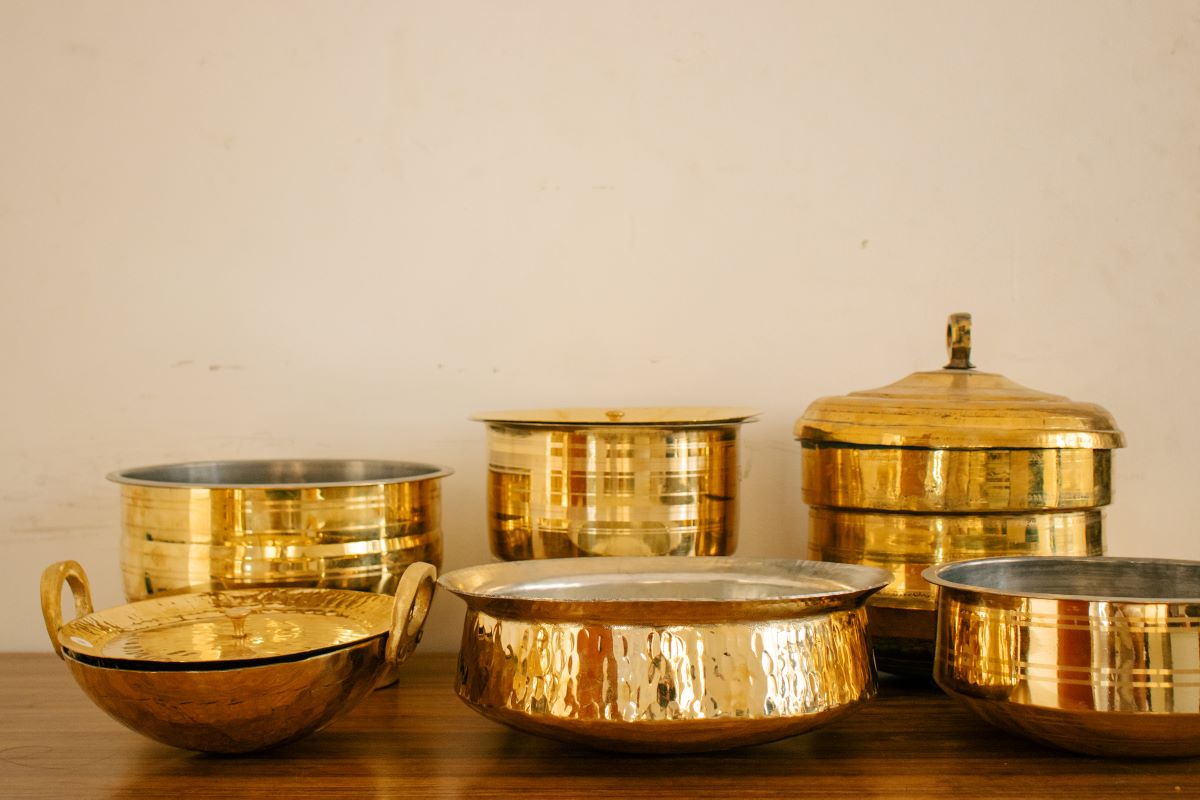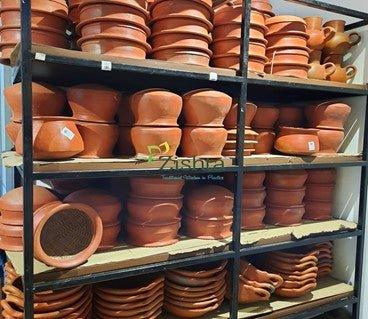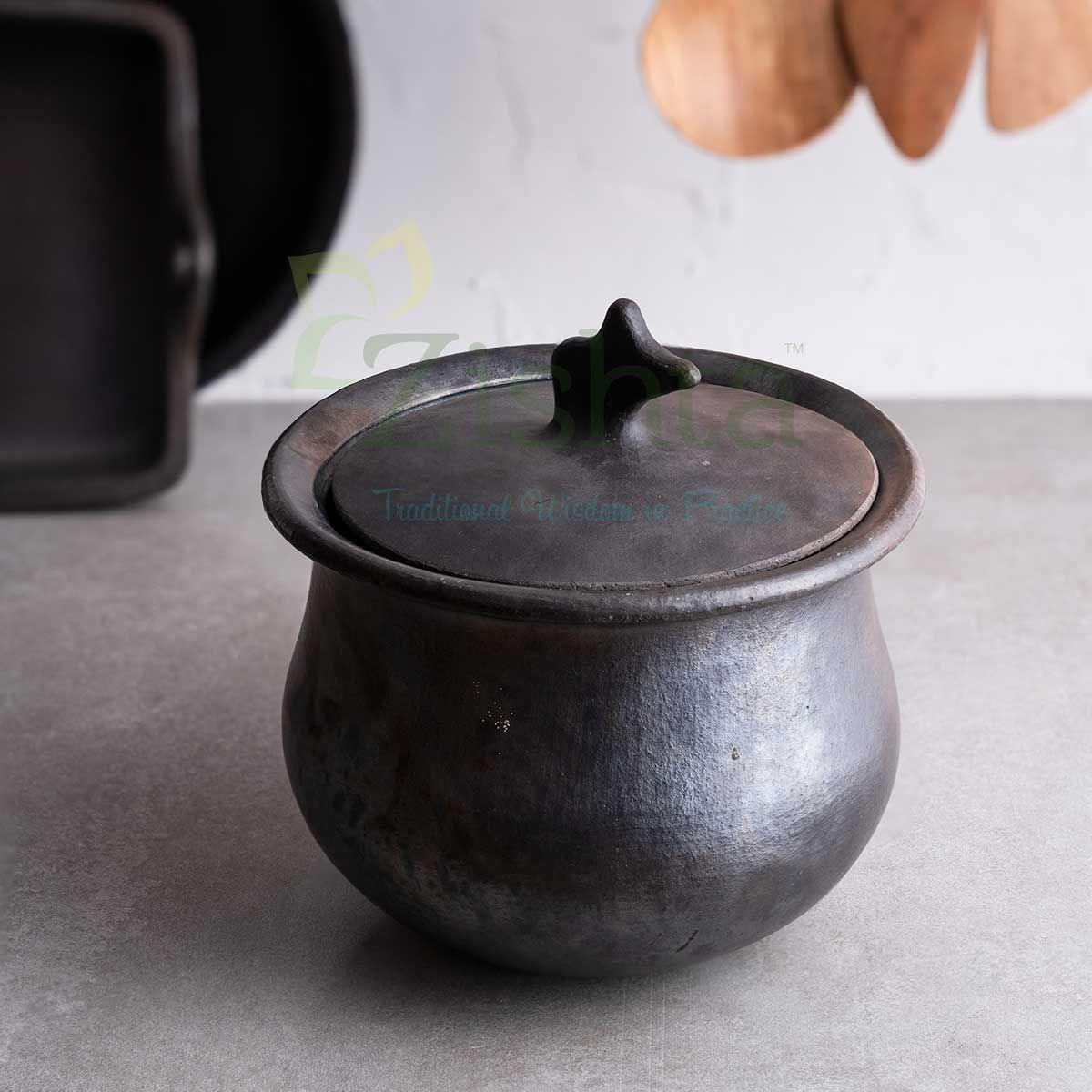What is Brass Cookware?
Brass cookware is cookware made of brass, a metal alloy composed of copper and zinc. Brass cookware is known for its ability to conduct heat evenly and quickly, making it a popular choice for cooking.
Brass cookware is typically lined with another metal called tin, to prevent acidic foods from reacting with the brass. Brass cookware can be used for a variety of cooking methods, including frying, sautéing, and braising.
Brass cookware is also prized for its durability and aesthetic appeal, as it can add a touch of elegance to any kitchen.
Traditional History of Brass Cookware in India
Brass cookware has a long history in India and has been used for centuries in traditional cooking. Brass vessels have been found in archaeological excavations dating back to the Indus Valley civilisation, which flourished in the Indian subcontinent from around 2600 BCE to 1900 BCE.
In Indian culture, brass utensils are considered auspicious and are often used during special occasions and religious ceremonies. Brass cookware is also popular in Ayurvedic cooking, as it is believed that cooking in brass vessels can enhance the health benefits of certain foods and spices.
In many regions of India, brass utensils are handcrafted by skilled artisans using traditional techniques passed down through generations. These artisans use a combination of hammering, shaping, and carving to create intricate designs on the brass cookware.
Today, brass cookware is still widely used in Indian kitchens and is particularly popular for making traditional dishes such as biryani, halwa, and kadhi.
However, due to the increased availability of other types of cookware, such as stainless steel and non-stick cookware, brass cookware has become less common in modern Indian households.
Traditional Clusters Making Brass Cookware
There are several regions in India known for their traditional brass cookware artisans, each with their unique styles and techniques. Here are a few examples:
- Jandialaguru, Punjab: Jandiala Guru is a town in the Tarn Taran district of Punjab, India, which has a long history of brass crafts and is known for its skilled brass artisans. The brass makers of Jandiala Guru specialize in creating traditional brass cookware, as well as other decorative and utilitarian brass items.
- Jaipur, Rajasthan: Known for its rich cultural heritage, Jaipur is also a hub for the traditional brass craft. Here, artisans create intricate brass cookware with detailed engravings and designs.
- Kerala: The southern state of Kerala is known for its brass utensils, particularly the uruli, a shallow brass vessel used for cooking and serving. Artisans in Kerala use traditional techniques like sand casting and hand hammering to create unique brass cookware as well.
- Tamil Nadu: In the town of Kumbakonam in Tamil Nadu, skilled brass artisans create a range of cookware including tawas, pans, and vessels for boiling milk. These artisans use techniques like sheet metal forming and brazing to create their brass cookware.
- Moradabad, Uttar Pradesh: This city in northern India is famous for its brass industry, and is home to many skilled artisans who create a wide range of brass cookware, from plates and bowls to larger vessels like handis and degchis.
These are just a few examples, as many regions throughout India have a rich history of brass craft and cookware production.
What can be cooked in brass cookware?
Brass cookware can be used to cook a wide variety of dishes, including:
- Rice dishes: Brass handis and degchis are commonly used in Indian cuisine to cook rice dishes such as biryani and pulao. The even heat distribution of brass cookware helps to ensure that the rice cooks evenly and doesn't burn.
- Curries: Brassware is also ideal for making curries and stews, as the brass helps to retain heat and distribute it evenly. This makes it easier to cook dishes for longer periods, allowing the flavours to develop and the meat or vegetables to become tender.
- Sweets: Brass cookware is also commonly used to make sweets such as halwa and laddoos, as the even heat distribution of the brass helps to prevent burning and ensure that the sweets cook evenly.
- Deep-fried foods: Brass kadai or brass fry pan, and Jalebi trays are often used to deep fry foods like pakoras, samosas, and other Indian snacks. The high sides of the kadai help to prevent oil splatters, while the brass material conducts heat efficiently for crispy and evenly fried food.

It's worth noting that brass is reactive to acidic ingredients like tomatoes, tamarind, or vinegar, which may cause a metallic taste and discolouration of the cookware. Therefore, it's best to use brass cookware for less acidic dishes or with a protective lining with tin.
What is Kalai (Tinning)? How frequently do we have to do Kalai for Brass Cookware?
Kalai or tinning is a process of coating brass cookware with a layer of tin, which helps to protect the brass from corrosion and also prevents the food from reacting with the brass. The frequency of kalai or tinning required for brass cookware depends on how frequently it is used and how well it is maintained.
In general, if you use your brass cookware frequently, it's a good idea to get it kalai or tinned every 1-2 years. If the cookware is not used as often, it may not need to be kalai or tinned as frequently.
Regular cleaning and maintenance can help to extend the life of your brass cookware and delay the need for kalai or tinning. After each use, make sure to clean the cookware thoroughly with warm water and mild detergent, then dry it completely to prevent any moisture from building up and causing corrosion.
If you notice any signs of corrosion or discolouration on your brass cookware, it's a good idea to get it kalai or tinned as soon as possible to prevent further damage.
What are the precautions to be taken while cooking with Brass Cookware:
Brass cookware has been used in Indian cooking for centuries, and it can be a great addition to any kitchen. However, some precautions should be taken when cooking with brass to ensure that it is safe and effective.
- Avoid using brass cookware for acidic foods if it has no Kalai (Tin Coating): Brass is reactive to acidic ingredients like tomatoes, tamarind, and vinegar, which can cause a metallic taste and discolouration of the cookware. Therefore, it's best to avoid using brass cookware for dishes that are high in acidity.
- Don't use harsh cleaning agents: Harsh or abrasive cleaning agents can damage the surface of the brass and make it more susceptible to corrosion. Instead, use a soft cloth or sponge to clean the cookware.
- Avoid overheating brass cookware: Brass cookware can be prone to hot spots, which can cause the food to burn or stick. It's important to avoid overheating the cookware and to stir the food regularly to ensure that it cooks evenly.
- Use utensils made of wood or silicone: Metal utensils can scratch the surface of the brass and cause it to corrode more quickly. It's best to use utensils made of wood or silicone to avoid damaging the cookware.
By following these precautions, you can help to ensure that your brass cookware is safe, effective, and long-lasting.
How to Maintain Brass Cookware?
Maintaining brass cookware is important to ensure that it lasts for a long time and remains safe to use. Here are some tips for maintaining brass cookware:
- Clean the cookware after each use: After each use, clean the brass cookware with warm water and mild detergent. Use a soft cloth or sponge to avoid scratching the surface. Rinse thoroughly and dry completely to prevent moisture from building up.
- Avoid using harsh cleaners or abrasive materials: Avoid using harsh or abrasive cleaning agents, as they can damage the surface of the brass and cause it to corrode more quickly. Instead, use mild detergents and soft cleaning materials.
- Polish the cookware regularly: Brass cookware can become tarnished over time. To restore its shine, polish the cookware regularly with a mixture of equal parts lemon juice and baking soda. Apply the mixture to the surface of the cookware with a soft cloth, then rinse thoroughly and dry completely.
- Store the cookware properly: Store the brass cookware in a dry place away from moisture to prevent corrosion. You can also wrap it in a soft cloth or paper to protect it from dust and scratches.
- Get it re-tinned: Over time, the tin coating on brass cookware can wear off, exposing the brass to the acids in food. If you notice that the tin coating is wearing off, get the cookware re-tinned by a professional.
By following these tips, you can help to ensure that your brass cookware remains in good condition for many years to come.
Do Brass Cookware work on Induction Cooktops?
No, brass cookware does not work on induction cooktops. Induction cooktops work by using an electromagnetic field to heat a ferromagnetic metal, such as cast iron or stainless steel. Brass is not ferromagnetic and therefore will not work on an induction cooktop.
However, induction-compatible cookware sets feature a layer of ferromagnetic material on the bottom of the cookware, allowing it to work on induction cooktops. Some manufacturers also offer induction-compatible brass cookware, but these products may be harder to find and more expensive than traditional brass cookware.
If you are looking to use brass cookware, it's important to note that it is best suited for gas stoves, Glass top/electric coil hobs or open-flame cooking. Brass cookware heats up quickly and evenly, making it ideal for traditional Indian cooking methods.
Can we store cooked food in brass with kalai for a long duration?
It is not recommended due to the following reasons:
- Sometimes if the kalai had worn off, the brass could start reacting with the acidic elements of the food cooked in them causing discolouration.
- When we store for a long and if the food type seems to dry out, then they will stick to the tin coating and you would have to scrub and remove the same. This can cause the tin coating to wear off faster.
It is for these reasons we do not recommend you store cooked food in brass cookware for a very long duration. Storing it for up to 2 -3 hours or lesser is ideal.
What are the Benefits of cooking in brass?
Cooking in brass has been a traditional method of cooking in India for centuries. Here are some potential benefits of cooking in brass:
- Even heat distribution: Brass is a good conductor of heat and distributes heat evenly, which can result in better cooking outcomes.
- Preservation of nutrients: The heat generated by brass cookware is relatively gentle, which can help to preserve the nutrients in food, especially in vegetables.
- Natural anti-microbial properties: Brass has natural anti-microbial properties that can help to inhibit the growth of harmful bacteria and germs in the food.
- Low maintenance: Brass cookware is relatively easy to maintain and does not require frequent seasoning or special cleaning other than tinning.
- Aesthetic appeal: Brass cookware has an attractive and elegant appearance that can enhance the overall look of the kitchen and the dining table.
- Durable: Brass Cookware is durable and if well maintained, can be passed on to generations.
It's important to note that there are also some precautions and limitations when using brass cookware, as mentioned earlier. However, many people continue to use and enjoy cooking in brass due to its traditional and cultural significance, as well as its potential benefits.
What are the Disadvantages of Brass cookware?
While there are many potential benefits of cooking in brass, there are also some disadvantages to using brass cookware. Here are a few to consider:
- Reactive metal: Brass is a reactive metal and can react with acidic or salty foods, which can cause the food to become discoloured and develop a metallic taste.
- Requires maintenance: Brass cookware requires regular maintenance, including polishing and re-tinning with kalai, to prevent tarnishing, corrosion, and potential health hazards.
- Not suitable for all cooktops: Brass cookware is not suitable for all types of cooktops, including induction cooktops, which require a ferromagnetic material to work.
- Can discolour over time: Brass cookware can discolour over time due to exposure to air, heat, and moisture. This can be remedied by regular polishing and maintenance, but it may not be suitable for those who prefer a low-maintenance cookware option.
- Cost: Brass cookware can be expensive compared to other types of cookware, especially if it is handmade or artisanal.
It's important to weigh the potential benefits and disadvantages of brass cookware when considering it as an option for your kitchen. If you do choose to use brass cookware, make sure to follow proper maintenance and cleaning procedures to ensure safe and effective use.
Which one is better for cooking - Brass or Copper?
Both brass and copper have their unique characteristics and advantages for cooking. Here are some factors to consider when comparing the two:
- Heat conductivity: Copper is a better conductor of heat than brass, which means it heats up more quickly and evenly. This makes copper ideal for tasks that require precise temperature control, such as making sauces or melting chocolate.
- Reactivity: Copper is also a reactive metal, which means it can react with acidic or alkaline foods, leading to discolouration and a metallic taste. Brass is also reactive, but to a lesser degree than copper.
- Maintenance: Copper cookware requires regular maintenance to keep it looking shiny and new, while brass cookware can develop a patina over time that many people find attractive.
- Durability: Both copper and brass cookware can be durable and long-lasting, but copper can be prone to denting and scratching, while brass can tarnish or corrode if not properly maintained.
- Cost: Copper cookware is generally more expensive than brass cookware, due to its superior heat conductivity and other desirable properties.
Ultimately, the choice between brass and copper cookware depends on your personal preferences, cooking style, and budget. Both materials can be suitable for a variety of cooking tasks and offer unique benefits and challenges.
Are Brass Cookware Safe to Use:
Brass utensils are generally considered safe for cooking and food preparation, as long as they are properly maintained and used correctly.
How to clean brass cookware?
Daily basis usage you can regular soap and a sponge for cleaning. Always wipe the surface dry after washing to prevent oxidisation and spotting. Once in a while to get back the shine, scrub the surface with lime or tamarind skin and clean. Wipe them dry to get the shine back.
Do not use steel wire scrubs or hard scrubs to clean as they can wear off the tin coating faster.
Can we boil milk in Brass?
Yes, you can boil milk in brass utensils. Please make sure you use one with a tin coating for this purpose.

Can we cook with tomatoes and acidic elements in Brass?
As long as the brass cookware has a tin coating, you can use it for all forms of cooking including tomatoes, tamarind, lime etc.




4 comments
Shivani Tripathi
This was such a helpful guide! I’ve recently started using brass cookware, and I can already see the difference in how my food tastes. The warmth and even cooking are amazing! I got a beautifully handcrafted brass kadai from Bombay Antiques, and it’s been a game changer in my kitchen. If anyone’s looking for authentic brass and copper cookware, you might love their collection too! 😊 bombayantiques.com
Shagunthala Thiyagarajah
Great experience!
Ordered from Norway
Nice product 😊
Parimala
Loved the product and amazing texture of food. Can the recoating of tin be done at zishta after an year or so?
Miguel Farinas
Hi there.
First and foremost congratulations on such beautiful products and great site.
I have bought recently some brassware with kalai. The first time I use the urili to fry some garlic in oil as part of a dish I notice after the cooking and after washing the urili, that the kalai is no longer smooth but it has been smudged with the heat. Is this normal? Should I worry about it?
Your know-how and reply would be highly appreciated
Best regards.
Leave a comment
All comments are moderated before being published.
This site is protected by hCaptcha and the hCaptcha Privacy Policy and Terms of Service apply.